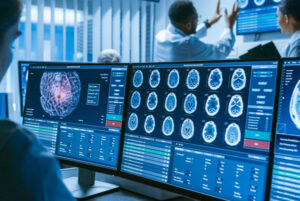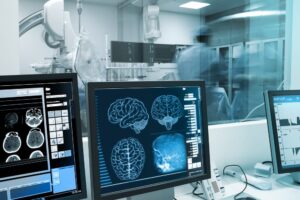The world of radiology has seen tremendous progress over the years, and one such advancement is the advent of PACS. With PACS, radiologists can store, manage, and distribute medical images and reports electronically. It enhances the diagnostic capabilities of medical professionals by allowing them to access patient information seamlessly. In this comprehensive guide to PACS in Radiology, we will delve deep into everything you need to know about this innovative technology!
Understanding PACS in Radiology
PACS has transformed medical imaging management, streamlining image acquisition, storage, and access across radiology PACS systems. It seamlessly connects various imaging modalities, like MRI and CT, enhancing patient care through rapid image access for change in healthcare. Moreover, it reduces film jackets and improves data management while safeguarding sensitive information. PAC adheres to the National Electrical Manufacturers Association standards for actual scanning and communication systems.
PACS in radiology allows for the secure storage of digital medical images, ensuring the confidentiality of sensitive information. It enables immediate access to patient data, enhancing communications systems and improving patient care. PAC decreases radiation exposure from imaging procedures, adhering to the National Electrical Manufacturers Association standards. It plays a crucial role in modern healthcare organizations, integrating seamlessly with electronic medical records for comprehensive patient histories and actual scanning.
Key Components of a PACS System

Medical imaging components, including PAC, are integral to a PACS system, connecting imaging modalities and enhancing patient care. The secure storage of digital medical images is crucial, as is the management of patient data for quick access. Additionally, a local server plays a vital role in supporting the storage and retrieval of sensitive patient information within the PAC system. These components ensure effective communication, data management, and access to medical information, contributing to the seamless operation of healthcare organizations.
The Interplay Between PACS and Other Information Systems
PACS seamlessly interfaces with hospital information systems and collaborates with radiology information systems for effective data management. Its software integrates flawlessly with medical imaging technology, enabling healthcare providers to store, manage, and share images. Additionally, PAC facilitates remote access to digital imaging for healthcare professionals, ensuring efficient communication and accessibility of patient-sensitive information. This interplay between PAC and other information systems enhances the overall functionality and communication system within the radiology department.
The Synergy Between PACS and RIS:
RIS and PACS collaborate for digital image management, enhancing healthcare workflow. This integration streamlines scheduling, reporting, and image management while improving communication within the healthcare field. The synergy optimizes the quality of patient care through the seamless coordination of these systems.
How PACS Interfaces with Other Medical Systems:
PAC interfaces with picture archiving and communication systems, ensuring secure network communication for sensitive patient data. It also integrates seamlessly with cloud computing for digital image storage. Additionally, PAC allows mobile access to medical images via smartphones and collaboration with nuclear medicine and related data. The software ensures the secure transmission of sensitive information and meets the standards set by the National Electrical Manufacturers Association.
Advantages of PACS in the Medical Field

PACS in the medical field enhances operational efficiency, enabling effective collaboration among healthcare professionals. It ensures timely diagnosis and treatment, optimizing patient care. Additionally, PAC reduces the storage space needed for medical images and streamlines image management, retrieval, and distribution, revolutionizing radiology departments. The integration of PACS with other information systems, such as RIS, further improves communication and workflow within the healthcare sector.
Healthcare professionals benefit from PACS as it allows access to images from any location. This facilitates collaboration among medical staff for better patient care. PACS software automates image storage, retrieval, and distribution, enhancing the accuracy and speed of medical imaging interpretation. Additionally, PAC contributes to the advancement of medical knowledge and lingo. The system’s ability to securely communicate sensitive information contributes to the overall improved efficiency and productivity in radiology departments.
Patients enjoy immediate access to their medical imaging results, empowering them to share images and access their medical data for personal use. PAC ensures secure storage of patient images and related data, allowing convenient access to medical images on mobile phones. This communications system changes healthcare by providing actual scanning and safe storage of sensitive information in compliance with the National Electrical Manufacturers Association standards.
Potential Drawbacks of PACS
The implementation of PACS necessitates a substantial initial investment, while also requiring continuous staff training and support. Moreover, challenges related to data security, privacy, and interoperability with legacy systems may arise. Additionally, there’s the potential risk of over-reliance on digital imaging technology. These drawbacks need to be carefully considered and addressed for the effective utilization of PAC in the field of radiology.
Understanding the Limitations of PAC
PACS systems may encounter downtime, impacting image access and workflow. Regular maintenance and updates are necessary, affecting operational efficiency. The management of digital imaging data storage requires careful attention to prevent data overload and complexities. Additionally, the potential for technology obsolescence poses a challenge for PAC, necessitating strategic upgrades to avoid system limitations. Embracing communications systems and changing healthcare may help address these limitations effectively.
Measures to Overcome PAC Drawbacks
To overcome PACS drawbacks, implementing secure network protocols ensures data integrity and patient information security. Integration of cloud computing can enhance storage capacity and accessibility. Regular system updates and maintenance play a crucial role in overcoming PAC drawbacks, while data encryption techniques enhance data security, protecting sensitive patient information. Effective data management strategies can mitigate the drawbacks of PAC systems.
A Look into Cloud-Based PAC

Cloud-based PACS systems provide a secure storage area for patient data, improving data management and ensuring the integrity of sensitive information. Utilizing cloud technology enables remote access to medical imaging data, streamlining image acquisition and improving workflow efficiency. Additionally, mobile access to cloud PAC allows healthcare professionals to view medical images from anywhere, promoting immediate access to patient information and enhancing overall patient care.
The healthcare industry is witnessing a shift towards cloud PACS systems driven by the need for scalable and cost-effective solutions. Cloud PACS promotes collaboration among healthcare providers, improving patient care quality, and offers an efficient and practical solution for managing digital medical images. The integration of cloud technology in PAC aligns with evolving healthcare industry standards and contributes to reducing radiation exposure through digital imaging. This transition marks a significant advancement in radiology PAC and communications systems, providing enhanced accessibility and security for sensitive medical information.
Cloud-based PACS systems offer enhanced flexibility in storing medical image volumes, supporting seamless scalability. The integration of cloud technology enables convenient mobile access to patient images and related data. However, challenges concerning data privacy and information security are prevalent. Despite this, the scalability of cloud PAC contributes to its increasing market share in the healthcare industry, providing healthcare organizations with ample opportunities to enhance patient care quality.
Affordable PACS to Improve Workflow Efficiency
Accessible PACS solutions are tailored to accommodate the budget constraints of smaller healthcare organizations, providing cost-effective options for managing digital medical images. Cloud-based PAC technology offers affordable remote access and storage, minimizing the need for extensive local infrastructure. These solutions contribute significantly to enhancing data management and ultimately improving the quality of patient care across medical centers.
SepStream offers a highly efficient and practical solution for managing digital medical images with our Pac System Radiology. By integrating cloud technology into our PAC, we align with evolving healthcare industry standards and contribute to reducing radiation exposure through digital imaging. This transition marks a significant advancement in radiology PACS and communications systems, providing enhanced accessibility and security for sensitive medical information.
Who are the Primary Users of PACS?
PACS systems are utilized by medical staff, radiologists, and healthcare professionals across various specialties. These software solutions enable easy access to and management of medical images and patient histories. Primary users include radiology specialists, nuclear medicine experts, IT staff, and medical imaging technologists. PACS technology supports immediate image access for healthcare professionals.
Considering the needs of medical practices, PACS is highly suitable for the efficient management of digital medical images. By implementing PAC, healthcare organizations can seamlessly store and retrieve patient images, ensuring easy access to patient information. With the flexibility and adaptability of PACS technology, it caters to a wide range of healthcare organizations.
Summary
To summarize, PACS (Picture Archiving and Communication System) has revolutionized the field of radiology with its efficiency, accessibility, and cost-saving capabilities. From streamlining workflows to enhancing patient care, PACS offers numerous advantages for healthcare professionals and patients alike. However, it’s important to be aware of the potential drawbacks and limitations of PAC, as well as the measures to overcome them.
Additionally, the emergence of cloud-based PACS has further expanded the possibilities in radiology, although it comes with its own set of benefits and challenges. Whether you’re a healthcare professional or considering implementing PACS in your practice, it’s crucial to evaluate the suitability and affordability of this system. Ultimately, PACS plays a vital role in modern radiology and is transforming the way medical imaging is stored, accessed, and shared.
